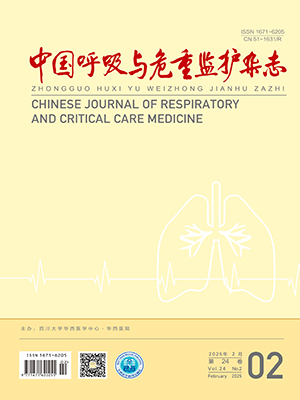| 1. |
Abu Rous F, Singhi EK, Sridhar A, et al. Lung cancer treatment advances in 2022. Cancer Invest, 2023, 41(1): 12-24.
|
| 2. |
Xia CF, Dong XS, Li H, et al. Cancer statistics in China and United States, 2022: profiles, trends, and determinants. Chin Med J (Engl), 2022, 135(5): 584-590.
|
| 3. |
Wu FY, Wang L, Zhou CC. Lung cancer in China: current and prospect. Curr Opin Oncol, 2021, 33(1): 40-46.
|
| 4. |
Fuziwara CS, Kimura ET. Insights into regulation of the miR-17-92 cluster of miRNAs in cancer. Front Med (Lausanne), 2015, 2: 64.
|
| 5. |
Hirsch FR, Scagliotti GV, Mulshine JL, et al. Lung cancer: current therapies and new targeted treatments. Lancet, 2017, 389(10066): 299-311.
|
| 6. |
Mamdani H, Matosevic S, Khalid AB, et al. Immunotherapy in lung cancer: current landscape and future directions. Front Immunol, 2022, 13: 823618.
|
| 7. |
尤程程, 黄益玲. 自噬与肺癌化疗和靶向药物耐药关系的研究进展. 现代肿瘤医学, 2022, 30(24): 4539-4544.
|
| 8. |
Zhu BW, Wu YQ, Niu LZ, et al. Silencing SAPCD2 represses proliferation and lung metastasis of fibrosarcoma by activating Hippo signaling pathway. Front Oncol, 2020, 10: 574383.
|
| 9. |
Oliver AL. Lung cancer: epidemiology and screening. Surg Clin North Am, 2022, 102(3): 335-344.
|
| 10. |
Kay BK, Williamson MP, Sudol M. The importance of being proline: the interaction of proline-rich motifs in signaling proteins with their cognate domains. FASEB J, 2000, 14(2): 231-241.
|
| 11. |
Santamaria-Kisiel L, Rintala-Dempsey AC, Shaw GS. Calcium-dependent and -independent interactions of the S100 protein family. Biochem J, 2006, 396(2): 201-214.
|
| 12. |
Xu X, Li W, Fan X, et al. Identification and characterization of a novel p42.3 gene as tumor-specific and mitosis phase-dependent expression in gastric cancer. Oncogene, 2007, 26(52): 7371-7379.
|
| 13. |
罗雅歌, 邢晓明, 王丽丽, 等. SAPCD2对人结肠癌RKO细胞增殖能力的影响. 精准医学杂志, 2018, 33(4): 346-350.
|
| 14. |
Wei DS. MiR-486-5p specifically suppresses SAPCD2 expression, which attenuates the aggressive phenotypes of lung adenocarcinoma cells. Histol Histopathol, 2022, 37(9): 909-917.
|
| 15. |
张馨木. p42.3基因在非小细胞肺癌中的表达情况及其意义评价[D]. 卫生部北京老年医学研究所.
|
| 16. |
Zhang Y, Liu JL, Wang J. SAPCD2 promotes invasiveness and migration ability of breast cancer cells via YAP/TAZ. Eur Rev Med Pharmacol Sci, 2020, 24(7): 3786-3794.
|
| 17. |
Weng YR, Yu YN, Ren LL, et al. Role of C9orf140 in the promotion of colorectal cancer progression and mechanisms of its upregulation via activation of STAT5, β-catenin and EZH2. Carcinogenesis, 2014, 35(6): 1389-1398.
|
| 18. |
Luo YG, Wang LL, Ran WW, et al. Overexpression of SAPCD2 correlates with proliferation and invasion of colorectal carcinoma cells. Cancer Cell Int, 2020, 20: 43.
|
| 19. |
Pastushenko I, Blanpain C. EMT transition states during tumor progression and metastasis. Trends Cell Biol, 2019, 29(3): 212-226.
|
| 20. |
Sun XM, Kaufman PD. Ki-67: more than a proliferation marker. Chromosoma, 2018, 127(2): 175-186.
|
| 21. |
Tsujimoto Y. bcl-2: antidote for cell death. Prog Mol Subcell Biol, 1996, 16: 72-86.
|
| 22. |
Ebrahim AS, Sabbagh H, Liddane A, et al. Hematologic malignancies: newer strategies to counter the BCL-2 protein. J Cancer Res Clin Oncol, 2016, 142(9): 2013-2022.
|
| 23. |
Huang Q, Li F, Liu XJ, et al. Caspase 3-mediated stimulation of tumor cell repopulation during cancer radiotherapy. Nat Med, 2011, 17(7): 860-866.
|
| 24. |
Zanotelli MR, Zhang J, Reinhart-King CA. Mechanoresponsive metabolism in cancer cell migration and metastasis. Cell Metab, 2021, 33(7): 1307-1321.
|
| 25. |
Matthaios D, Tolia M, Mauri D, et al. YAP/Hippo pathway and cancer immunity: it takes two to tango. Biomedicines, 2021, 9(12): 1949.
|
| 26. |
Piccolo S, Dupont S, Cordenonsi M. The biology of YAP/TAZ: Hippo signaling and beyond. Physiol Rev, 2014, 94(4): 1287-1312.
|
| 27. |
Hansen CG, Moroishi T, Guan KL. YAP and TAZ: a nexus for Hippo signaling and beyond. Trends Cell Biol, 2015, 25(9): 499-513.
|
| 28. |
Nguyen CDK, Yi CL. YAP/TAZ signaling and resistance to cancer therapy. Trends Cancer, 2019, 5(5): 283-296.
|
| 29. |
Zhu BW, Finch-Edmondson M, Leong KW, et al. LncRNA SFTA1P mediates positive feedback regulation of the Hippo-YAP/TAZ signaling pathway in non-small cell lung cancer. Cell Death Discov, 2021, 7(1): 369.
|
| 30. |
Mitchell E, Mellor CEL, Purba TS. XMU-MP-1 induces growth arrest in a model human mini-organ and antagonises cell cycle-dependent paclitaxel cytotoxicity. Cell Div, 2020, 15: 11.
|
| 31. |
Hao X, Zhao J, Jia LY, et al. XMU-MP-1 attenuates osteoarthritis via inhibiting cartilage degradation and chondrocyte apoptosis. Front Bioeng Biotechnol, 2022, 10: 998077.
|




